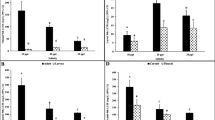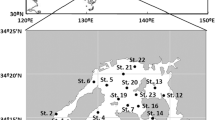Abstract
After the accidental release of crude oil in marine environment, dispersants are applied on sea surface transferring oil into the water column where it can be broken down by biodegradation, thereby reducing potential pollution to coastal areas. Before they can be used in the wild, the ecotoxicity of such dispersants is usually evaluated with toxicity assays using algae, crustacean and fishes. Nowadays, there is a need to find alternative species to reduce the use of vertebrates both for ethical considerations and for reducing the cost of bioassays. Ciona robusta is a solitary ascidian that inhabits shallow waters and marine coastal areas. This species has been recently adopted as valuable biological model for ecotoxicity studies, thanks to its rapid embryonic and larval development, resemblance to vertebrates, and low risk of ethical issues. On this ground, the lethal and sublethal toxicity of two dispersants has been evaluated on Ciona juveniles. At this stage, the organisms become filter-feeders and the morphological alterations of the organs can be easily observed. The median lethal concentrations at 96 h (96hLC50) for Dispersant 1 (non-ionic surfactant) and for Dispersant 2 (mixture of non-ionic surfactants and anionic surfactants) are 41.6 mg/L (38.6–44.9) and 92.5 mg/L (87.7–97.5), respectively. The Ciona juvenile model was compared to Dicentrarchus labrax fish juveniles test, and it showed increased sensitivity for Ciona to these compounds. These results suggest that 96 h mortality test bioassay could be a good alternative method to 96 h mortality assay with D. labrax, limiting the use of vertebrates for dispersant toxicity.



Similar content being viewed by others
References
Anderson HE, Christiaen L (2016) Ciona as a simple chordate model for heart development and regeneration. J Cardiovasc Dev Dis 3(3):1–20
Berrill NJ (1947) The development and growth of Ciona. J Mar Biol Assoc U K 26:616–625. https://doi.org/10.1017/S0025315400013825
Chiba S, Sasaki A, Nakayama A, Takamura K, Satoh N (2004) Development of Ciona intestinalis juveniles (through 2nd ascidian stage). Zool Sci 21:285–298. https://doi.org/10.2108/zsj.21.285
Conti D, Balzamo S, Paina A, Martone C, Raso E, Cadoni F, Savorelli F, Croppo M, Bellaria V, Pati A (2015) European sea bass (Dicentrarchus labrax L. 1758) as a sentinel species in Europe to study the effects of contaminants. Annu Res Rev Biol 8(4):1–13
Delsuc F, Brinkmann H, Chourrout D, Philippe H (2006) Tunicates and not cephalochordates are the closest living relatives of vertebrates. Nature 439(7079):965–968 https://hal.archives-ouvertes.fr/halsde-00315436/document
Dybern, B. I. (1965). The life cycle of Ciona intestinalis (L) f. typical; in relation to environmental temperature Oikos(16), 109–131
Halder ME, Kienzler A, Whelan M, Worth A (2014) EURL ECVAM Strategy to replace, reduce and refine the use of fish in aquatic toxicity and bioaccumulation testing. Publications Office of the European Union. https://doi.org/10.2788/084219
IMO/UNEP (2011) Guidelines for the use of dispersants for combating oil pollution at sea in the Mediterranean region. Part II: Basic information on dispersants and their application. www.rempec.org
Lambert CC, Brandt CL (1967) The effect of light on the spawning of Ciona intestinalis. Biol Bull 132:222–228
Lillicrap A, Belanger S, Burden N, Du Pasquier D, Embry MR, Halder M, Lampi MA, Lee L, Norberg-King T, Rattner BA, Schirmer K, Thomas P (2016) Alternative approaches to vertebrate ecotoxicity tests in the 21st century: a review of developments over the last 2 decades and current status. Environ Toxicol Chem 35(11):2637–2646. https://doi.org/10.1002/etc.3603
Manfra L, Tornambè A, Guyomarch J, Le Guerrogue P, Kerambrun L, Rotini A, Savorelli F, Onorati F, Magaletti E (2017) Dispersant approval procedures in France and Italy: a comparative ecotoxicity study. Ecotoxicol Environ Saf 143:180–185
Manfra L, Tornambè A, Guyomarch J, Duboscq K, Faraponova O, Sebbio C (2019) Could a harmonized tiered approach assess dispersant toxicity in Italy and France? Environ Sci Pollut Res. https://doi.org/10.1007/s11356-019-06535-7
Mansueto V, Cangialosi MV, Faqi AS (2011) Postembryonic development effect of Bisphenol a and Tributyltin effects in Ciona intestinalis. Caryologia 64(4):478–484
Mariani L, De Pascale D, Faraponova O, Tornambè A, Sarni A, Giuliani S, Ruggiero G, Onorati F, Magaletti E (2006) The use of a test battery in marine ecotoxicology: the acute toxicity of sodium dodecyl sulfate. Environ Toxicol 21:373–379 https://onlinelibrary.wiley.com/doi/abs/10.1002/tox.20204
Messinetti S, Mercurio S, Parolini M, Sugni M, Pennati R (2017) Effects of polystyrene microplastics on early stages of two marine invertebrates with different feeding strategies. Environ Pollut 237:1080–1087. https://doi.org/10.1016/j.envpol.2017.11.030
Millar RH (1953) Ciona. In: L.M.B.C. Memoirs on Typical British Marine Plants and Animals. Liverpool University Press, Liverpool, pp 1–123
OECD/203 (1992) Test no. 203: fish, acute toxicity test, OECD guidelines for the testing of chemicals, Section 2. OECD Publishing Paris
Okamura Y, Nishino A, Murata Y, Nakajo K, Iwasaki H, Ohtsuka Y, Tanaka-Kunishima M, Takahashi N, Hara Y, Yoshida T, Nishida M, Okado H, Watari H, Meinertzhagen IA, Satoh N, Takahashi K, Satou Y, Okada Y, Mori Y (2005) Comprehensive analysis of the ascidian genome reveals novel insights into the molecular evolution of ion channel genes. Physiol Genomics 22(3):269–282 Retrieved from https://www.physiology.org/doi/pdf/10.1152/physiolgenomics.00229.2004
Petersen JK, Schou O, Thor P (1995) Growth and energetics in the ascidian Ciona intestinalis. Mar Ecol Prog Ser 120:175–184. https://doi.org/10.3354/meps120175
Ribelles A, Carrasco C, Rosety M, Aldana M (1995) A histochemical study of the biological effects of sodium dodecyl sulfate on the intestine of gilthead seabream, Sparus aurata. Ecotoxicol Environ Saf 32:131–138 https://www.sciencedirect.com/science/article/pii/S0147651385710937?via%3Dihub
Rosety RM, Ordonez FJ, Rosety M, Rosety JM, Rosety I, Ribelles A, Carrasco C (2001) Morphohistochemical changes in the gills of turbot, Scophthalmus maximus L ., induced by sodium dodecyl sulfate. Ecotoxicol Environ Saf 3:223–228
Rotini A, Manfra L, Canepa S, Tornambè A, Migliore L (2015) Can Artemia hatching assay be a (sensitive) alternative tool to acute toxicity test. Bull Environ Contam Toxicol 95(6). https://doi.org/10.1007/s00128-015-1626-1
Sasakura Y, Mita K, Ogura Y, Horie T (2012) Ascidians as excellent chordate models for studying the development of the nervous system during embryogenesis and metamorphosis. Develop Growth Differ 54(3):420–437 https://onlinelibrary.wiley.com/doi/full/10.1111/j.1440-169X.2012.01343.x
Sato Y, Terakado K, Morisawa M (1997) Test cell migration and tunic formation during post-hatching development of the larva of the ascidian, Ciona intestinalis. Develop Growth Differ 39:117–126 https://onlinelibrary.wiley.com/doi/abs/10.1046/j.1440-169X.1997.00013.x?sid=nlm%3Apubmed
Satoh N (1994) Developmental biology of ascidians. Cambridge University Press, New York
Scott MJ, Jones MN (2000) The biodegradation of surfactants in the environment. Biochim Biophys Acta (BBA) 1508(1–2):235–251
Willey A (1893a) Studies on the Protochordata. I. on the origin of the branchial stigmata, praeoral lobe, endostyle, atrial cavities, etc. in Ciona intestinalis, Linn., with remarks on Clavelina lepadiformis. Q J Micr Sci 34:317–360
Willey A (1893b) Studies on the Protochordata. II. The development of the neuro-hypophyseal system in Ciona intestinalis and Clavelina lepadiformis, with an account of the origin of the sense organs in Ascidia mentula. Q J Micr Sci 35:295–316
Wise J, Wise JP (2011) A review of the toxicity of chemical dispersants. Rev Environ Health 26(4):281–300 https://www.ncbi.nlm.nih.gov/pmc/articles/PMC6730675/pdf/nihms-1048563.pdf
Yamamoto M, Okada T (1999) Origin of the gonad in the juvenile of a solitary ascidian, Ciona intestinalis. Dev Growth Differ 41:73–79 https://onlinelibrary.wiley.com/doi/abs/10.1046/j.1440-169x.1999.00410.x?sid=nlm%3Apubmed
Author information
Authors and Affiliations
Corresponding author
Additional information
Responsible Editor: Philippe Garrigues
Publisher’s note
Springer Nature remains neutral with regard to jurisdictional claims in published maps and institutional affiliations.
Electronic supplementary material
ESM 1
(DOCX 28.2 kb)
Rights and permissions
About this article
Cite this article
Eliso, M.C., Manfra, L., Savorelli, F. et al. New approaches on the use of tunicates (Ciona robusta) for toxicity assessments. Environ Sci Pollut Res 27, 32132–32138 (2020). https://doi.org/10.1007/s11356-020-09781-2
Received:
Accepted:
Published:
Issue Date:
DOI: https://doi.org/10.1007/s11356-020-09781-2




